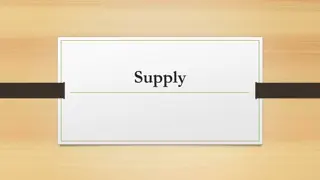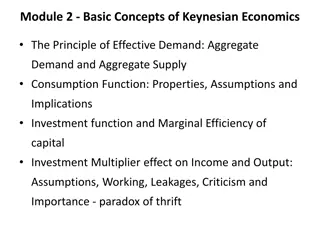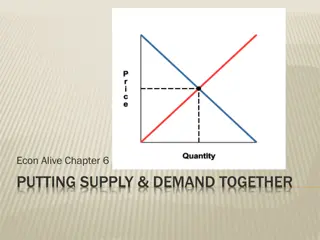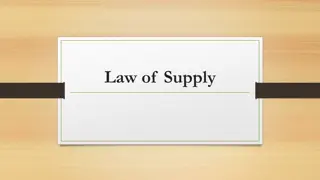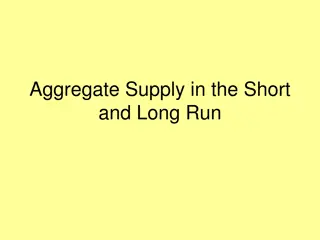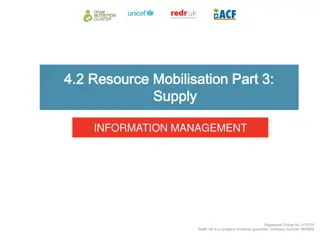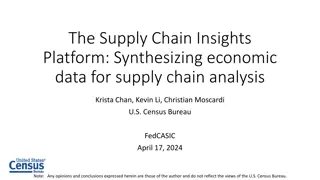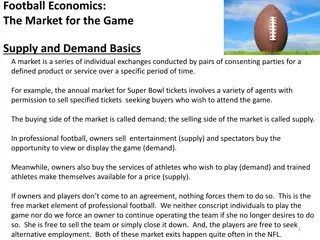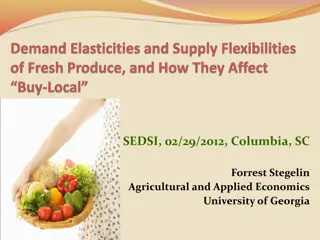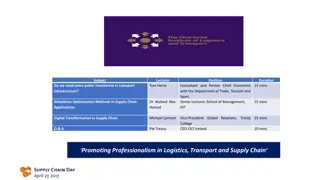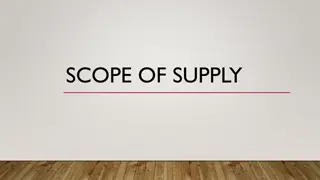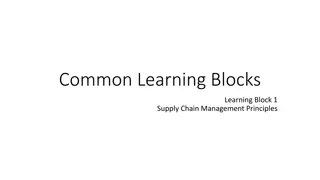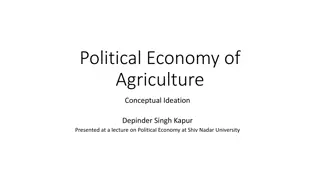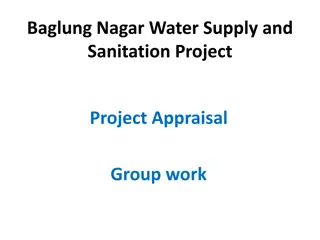Understanding Supply in Economics
Explore the concept of supply in economics, including its definition, determinants, and graphical representation. Learn about the law of supply, non-price factors affecting supply, and key terms such as market supply and horizontal summation. Understand the difference between a change in quantity supplied and a change in supply, and how they impact the supply curve. Enhance your knowledge of why producers supply more at higher prices and the importance of ceteris paribus assumption in creating supply curves.
Download Presentation

Please find below an Image/Link to download the presentation.
The content on the website is provided AS IS for your information and personal use only. It may not be sold, licensed, or shared on other websites without obtaining consent from the author. Download presentation by click this link. If you encounter any issues during the download, it is possible that the publisher has removed the file from their server.
E N D
Presentation Transcript
3b Supply This web quiz may appear as two pages on tablets and laptops. I recommend that you view it as one page by clicking on the open book icon at the bottom of the page.
3b - Supply Must Know / Outcomes: define supply (note: it has a DIFFERENT DEFINITION in economics) be able to correctly draw and label a supply graph if the price of pizza goes up why does the supply not change? why do economists employ the ceteris paribus assumption when creating a supply curve? what is the law of supply? why is the supply curve upward sloping (two explanations) list the non-price determinants of supply (Pe, Pog, Pres, Tech, Taxes, Nprod) or (P,P,P,T,T,N) and understand how they affect the supply schedule and curve. This is VERY IMPORTANT. BE ABLE TO DO THIS! See the 3a/3b/3c yellow pages. explain the difference between the a "change in the quantity supplied" and a "change in supply" what is an increase in supply and a decrease in supply and show how they affect the supply schedule and the supply curve what is "market supply"?
3b - Supply KEY TERMS: supply, quantity supplied, market supply, horizontal summation, law of supply, change in supply, change in quantity supplied, increase in supply, decrease in supply, non-price determinants of supply
1. DEFINE -- Supply is: 1. A mathematical representation of the quantity of a good that a supplier will put on the market 2. A schedule showing the amount of a good that consumers are willing to buy at various prices 3. A schedule showing the amount of a good that producers are willing to sell at various prices 4. The amount of a good that is available for sale
1. DEFINE -- Supply is: 1. A mathematical representation of the quantity of a good that a supplier will put on the market 2. A schedule showing the amount of a good that consumers are willing to buy at various prices 3. A schedule showing the amount of a good that producers are willing to sell at various prices 4. The amount of a good that is available for sale
2. DESCRIBE -- The reason that producers supply more to a market only at higher prices is that as the price increases: 1. Producers costs of producing that good falls 2. Producers costs of producing that good increases 3. Consumers demand more so producers must raise the price 4. Consumers demand less so producers must raise the price
2. DESCRIBE -- The reason that producers supply more to a market only at higher prices is that as the price increases: 1. Producers costs of producing falls 2. Producers costs of producing increases 3. Consumers demand more so producers must raise the price 4. Consumers demand less so producers must raise the price
3. As the price of apples increases, apple growers will: 1. Decrease the supply of apples 2. Increase the supply of apples 3. Switch to less expensive methods of production 4. Increase the quantity of apples supplied
3. As the price of apples increases, apple growers will: 1. Decrease the supply of apples 2. Increase the supply of apples 3. Switch to less expensive methods of production 4. Increase the quantity of apples supplied
4. Which of the following will not shift the supply curve of product X? 1. A change in the price of resources used to produce X 2. A change in the price of other goods also produced by the makers of X 3. A change in the technology used to produce X 4. A change in the price of X
4. Which of the following will not shift the supply curve of product X? 1. A change in the price of resources used to produce X 2. A change in the price of other goods also produced by the makers of X 3. A change in the technology used to produce X 4. A change in the price of X
Change in Supply Increase in Supply: Decrease in supply:
Non-Price Determinants of Supply Pe -- expected price Pog -- price of other goods produced by the same firm Pres -- price of resources T production technology T --taxes and subsidies N -- number of sellers YP 35
5. The supply curve of apples will shift to the right if: 1. Very bad weather afflicts the apple-growing areas of the country Apples are rumored to have been treated with cancer-causing insecticides The government required that all employees in apple orchards are given more health benefits Fruit growers see the price of pears decreasing permanently 2. 3. 4.
5. The supply curve of apples will shift to the right if: 1. Very bad weather afflicts the apple-growing areas of the country Apples are rumored to have been treated with cancer-causing insecticides The government required that all employees in apple orchards are given more health benefits Fruit growers see the price of pears decreasing permanently 2. 3. 4.
6. If a pretzel maker hears rumors that pretzel prices will fall at the end of the month, the firm now: 1. Saves it supply for selling at a future date 2. Increases the supply 3. Decreases the supply 4. Waits to supply pretzels when the market is more stable
6. If a pretzel maker hears rumors that pretzel prices will fall at the end of the month, the firm now: 1. Saves it supply for selling at a future date 2. Increases the supply 3. Decreases the supply 4. Waits to supply pretzels when the market is more stable
7. Which of the following will cause a decrease in the market supply for ice cream? 1. An increase in the price of ice cream 2. A decrease in the price of ice cream 3. An increase in the price of milk used to make ice cream 4. An expectation that the price of ice cream will be lower in the future
7. Which of the following will cause a decrease in the market supply for ice cream? 1. An increase in the price of ice cream 2. A decrease in the price of ice cream 3. An increase in the price of milk used to make ice cream 4. An expectation that the price of ice cream will be lower in the future
8. An improvement in production technology will: 1. Shift the demand curve to the left 2. Shift the supply curve to the left 3. Shift the demand curve to the right 4. Shift the supply curve to the right
8. An improvement in production technology will: 1. Shift the demand curve to the left 2. Shift the supply curve to the left 3. Shift the demand curve to the right 4. Shift the supply curve to the right
9. Refer to the table. In relation to column (1), a change from column (2) to column (3) would most likely be caused by: 1. Government reducing the tax on the good 2. Expectations of higher future prices 3. An increase in consumer incomes 4. An increase in input prices
9. Refer to the table. In relation to column (1), a change from column (2) to column (3) would most likely be caused by: 1. Government reducing the tax on the good 2. Expectations of higher future prices 3. An increase in consumer incomes 4. An increase in input prices
10. The market supply of a good or service: 1. Is the horizontal summation of the individual supply curves 2. Is the vertical summation of the individual supply curves 3. Is the inverse relationship between price and quantity supplied 4. All of the above
10. The market supply of a good or service: 1. Is the horizontal summation of the individual supply curves 2. Is the vertical summation of the individual supply curves 3. Is the inverse relationship between price and quantity supplied 4. All of the above








